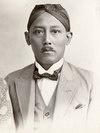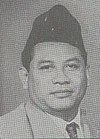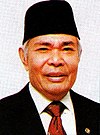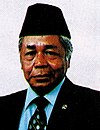Supreme Advisory Council
| Dewan Pertimbangan Agung | |
 Office of the council, 2000 | |
| Agency overview | |
|---|---|
| Formed | 25 September 1945 |
| Dissolved | 31 July 2003 |
| Superseding agency | |
| Website | Official website |

The Supreme Advisory Council (Indonesian: Dewan Pertimbangan Agung, DPA), was an advisory council for the President of Indonesia which existed from 1945 to 1950, and then again from 1959 to 2003. Largely composed of senior and retired government figures, the DPA was generally regarded as powerless. Its functions were limited to offering proposals to the government on matters of national importance as well as opinions on matters raised by the president.[1] The DPA was succeeded by the Presidential Advisory Council in 2007.
Background
[edit]There was no definitive source about the background of the council's formation when it was embodied in the Constitution of Indonesia. In the supplement of the constitution, the council was compared to a council of state, leading to possibility that the council was based on the Council of the Indies in the Dutch East Indies. In the founding fathers of Indonesia itself, there was an opinion that the council was based on the village traditions in Indonesia, on which the villagers decided matters and resolve conflict with a "council of elders", headed by a id:Kepala desa. Supreme Advisory Council was claimed to be par with a village "council of elders"[citation needed], which was composed of retired politicians, although a village is hardly an sprawling fantastically diverse archipelagic country with vast differences in spiritual belief systems and countless local languages spoken. This may also reflect a degree of cultural nostalgia that exalts the model village as cultural and spiritual roots of mannerisms and customs, broad similarities exist in India where a kepala desa is replaced by a sarpanch, as well as the dynamic of Thainess coupled with agrarian nostalgia, Cambodian Khmer Rouge model agrarianism, at the expense of Western and global governance ideals like government transparency that respect modern social complexities, the far higher degree to which exist specialization of labor in urban environments, and sheer bureaucratic breadth and scale. Therefore, a governance model dating back to prehistory, perhaps suitable for a small footprint and scale of closely related individuals such as a village, merely invites disconnect -- fiery demonstrations by mobs and special interest groups alike, in the crowded megacities, not to mention autocratic crushing of dissent and the human rights abuses that follow.
History
[edit]The council was established one month and one week following the proclamation of Indonesian Independence. When it was first established on September 25, 1945. The name for the council was Advisory Council, which was suggested by Mohammad Yamin. The name was approved by Sukarno. However, several months later, the name was changed to the Supreme Advisory Body. It was later changed again into the Supreme Advisory Council.[2] The Supreme Advisory Council was formed with the announcement of the formation of the council in the Official Gazette No. 4 of 1945. Due to the emergency situation of the country, the council was not formed with a binding law. The priority at that time was to form a temporary advisory council as soon as possible under the Constitution of Indonesia.[3] The council was formed on 25 September 1945 with Margono Djojohadikusumo as its chairman and Radjiman Wediodiningrat, Syech Dahlan Djambek, Agus Salim, K.R.M.T.H. Wurjaningrat, H. Adnan, Mochammad Enoch, Dr. Latumeten, Pangeran Mochammad Noor, Sukiman Wirjosandjojo, Nyonya Soewarni Pringgodigdo, as its members.[4]
Several months after its formation, on 6 November 1945, chairman of the council Margono resigned from his position. He was replaced by Wiranatakusumah on 29 November 1945. Later, in 1948, there was an addition of eleven members to the council, namely Ario Soerjo, Sutardjo Kartohadikusumo, Abdul Wahab Hasbullah, Ki Hadjar Dewantara, Frits Laoh, Daud Beureu'eh, Anwarudin, Oerip Soemohardjo, Ernest Douwes Dekker, Moch. Sjafei, and Liem Ing Hwie. On 24 April 1948, Wiranatakusumah was installed as the Wali Negara of Pasundan. Ario Soerjo replaced him as the chairman, but several days later he was assassinated on 10 November 1948. To replace him, the vice chairman of the council Sutardjo Kartohadikusumo was installed on 15 November 1948. Ki Hadjar Dewantara was later appointed as vice chairman of the council. During the liberal democracy period in Indonesia, the organization was dissolved in 1950, and was restructured into the National Council (Indonesian: Dewan Nasional) on 1957. The National Council was dissolved in 1959, and formed the Provisional Supreme Advisory Council, with Sukarno, the president of Indonesia, as its chairman.[citation needed]
After the fall of Sukarno, the council was restored as a structural organization in 1967. It was dissolved on 31 July 2003 after the amendments to the Constitution of Indonesia. The functions of the council, which is previously regulated in the section IV of the constitution, was removed. Professor Harun Al-Rasjid from the Law Faculty of the University of Indonesia, a critic of the operations of the council, dubbed the DPA as the Dewan Paling Anteng (Most Serene Council). Rasjid stated that the result of the Supreme Advisory Council was unknown by the public and that its existence should be reviewed.[clarification needed]
Potential Revival and Return
[edit]Despite its constitutional basis revoked from constitution, DPA plotted to be revived in future Prabowo administration.[5] Even being returned, future DPA only nomenclature change of current Presidential Advisory Council (Wantimpres) and do not have its original power it had during pre-amendment Indonesian Constitution of 1945.[5] The bill for returning DPA was accepted to be processed into next reading and discussion by the DPR on 11 July 2024.[6]
List of chairmen
[edit]| No. | Portrait | Name (Birth–Death) |
Term | Deputy | ||
|---|---|---|---|---|---|---|
| 1 | 
|
Margono Djojohadikusumo (1894–1978) |
25 September 1945 – 6 November 1945 |
Agus Salim | ||
| 2 | 
|
Wiranatakusumah V (1888–1965) |
29 November 1945 – 24 April 1948 |
Agus Salim (1945–1946) Soekiman Wirjosandjojo Ario Soerjo | ||
| 3 | 
|
Ario Soerjo (1898–1948) |
24 April 1948 – 10 November 1948 |
Sutardjo Kartohadikusumo | ||
| 4 | 
|
Sutardjo Kartohadikusumo (1890–1976) |
10 November 1948 – 17 August 1950 |
Vacant | ||
| Body dissolved (1950–1959) | ||||||
| 5 | 
|
Sukarno (1901–1970) |
22 July 1959 – 23 April 1966 |
Roeslan Abdulgani (1959–1962) Sartono Sujono Hadinoto | ||
| – | 
|
Johannes Leimena (1905–1977) |
23 April 1966 – 4 March 1968 |
Sartono[7] | ||

|
Muhammad Dahlan (1909–1977) | |||||
| 6 | 
|
Wilopo (1909–1981) |
4 March 1968 – 31 March 1978 |
Muhammad Ilyas (1968–1970)[8] Sarbini Martodihardjo Alamsyah Ratu Perwiranegara | ||
| 7 | 
|
Idham Chalid (1921–2010) |
31 March 1978 – 19 March 1983 |
Sunawar Sukowati R. Soedjono Jailani Naro (1978–1983)[10] M. M. R. Kartakusuma Djatikoesoemo | ||
| 8 | 
|
Maraden Panggabean (1922–2000) |
19 March 1983 – 23 March 1988 |
Jailani Naro Sapardjo (1983–1988) Ali Murtopo Makmun Murod Sunawar Sukowati Wignyosumarsono | ||
| 9 | 
|
Sudomo (1926–2012) |
23 March 1988 – 16 March 1998 |
Makmun Murod Hartono Mardjono Ben Mang Reng Say Sugandhi (1988–1993)[11] Sugiarto | ||
| 10 | 
|
A. A. Baramuli (1930–2006) |
16 March 1998 – 29 October 1999 |
Achmad Tirtosudiro Suparman Achmad Jusuf Syakir Agus Sudono[13] | ||
| 11 | 
|
Achmad Tirtosudiro (1922–2011) |
29 October 1999 – 31 July 2003 |
Sulasikin Murpratomo Tarub Ahmad Bagdja Agus Sudono | ||
| Replaced by the Presidential Advisory Council | ||||||
References
[edit]Citations
[edit]- ^ Cribb & Kahin 2004, p. 116.
- ^ Wantimpres 2017, p. 3
- ^ Baramuli & Gafur 2000, p. 17
- ^ Baramuli & Gafur 2000, pp. 17–18
- ^ a b Media, Kompas Cyber (2024-07-12). "Mengenal DPA, Lembaga Tinggi Negara yang Dihapus di UUD tapi Mau "Dihidupkan" Lagi". KOMPAS.com (in Indonesian). Retrieved 2024-07-16.
- ^ "Revisi UU Wantimpres Jadi Usul Inisiatif DPR, Ubah Nomenklatur Jadi Dewan Pertimbangan Agung". Tribunnews.com (in Indonesian). 2024-07-11. Retrieved 2024-07-16.
- ^ Ghazali 1986, p. 463.
- ^ "Wilopo dan Iljas dilantik" [Wilopo and Iljas is installed]. Kompas (in Indonesian). Jakarta. 4 March 1968. Retrieved 10 November 2019.
- ^ "Presiden lantik para anggota DPA" [President installed members of the Supreme Advisory Council]. Kompas (in Indonesian). Jakarta. 9 August 1973. Retrieved 10 November 2019.
- ^ Ghazali 1986, p. 467.
- ^ Indonesian Presidential Documentation Team 2003, pp. 64–65
- ^ "Sudomo Menjadi Ketua DPA" [Sudomo Becomes the Chairman of the Supreme Advisory Council]. Kompas (in Indonesian). Jakarta. 29 June 1993. Retrieved 10 November 2019.
- ^ Pour 2000, p. 387
Sources
[edit]- Baramuli, Arnold Achmad; Gafur, Abdul (2000), DPA Dari Zaman Ke Zaman [DPA From Time to Time] (in Indonesian), Jakarta: Pustaka Sinar Harapan
- Cribb, Robert; Kahin, Audrey (2004). Historical Dictionary of Indonesia. Lanham, Maryland: Scarecrow Press. ISBN 978-0-8108-4935-8.
- Ghazali, Zulfikar (1986). "DPA Dalam Sejarah Konstitusi Republik" [The DPA in the History of the Constitution of the Republic]. Hukum Dan Pembangunan (in Indonesian). 16 (5): 450–468. doi:10.21143/jhp.vol16.no5.1216. ISSN 0125-9687.
- Wantimpres (2017), The Presidential Advisory Council 2015-2019: History, Tasks, and Functions (PDF), Jakarta, ISBN 978-602-61565-0-1
{{citation}}: CS1 maint: location missing publisher (link) - Indonesian Presidential Documentation Team (2003), Jejak Langkah Pak Harto 21 Maret 1988 – 11 Maret 1993 [Footsteps of Mr. Harto 21 March 1988 – 11 March 1993] (in Indonesian), Jakarta: Citra Kharisma Bunda Jakarta
